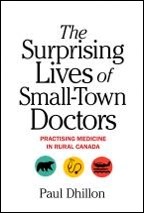Edited by Dr. Paul Dhillon
Published by University of Regina Press
$21.95 ISBN 978-0-88977-431-5
“All doctors, no matter how great or experienced, are a work in progress. They call it practicing medicine for a reason.” So declares Dr. Aleem Jamal, one of 40 doctors who relate their experiences in The Surprising Lives of Small-Town Doctors, edited by Dr. Paul Dhillon.
This 222-page book contains 40 stories from all 10 Canadian provinces and three territories. One story is in French with English translation, and five are by Saskatchewan physicians. The stories are split almost equally between male and female doctors.
As editor, Dr. Dhillon introduces each doctor with a short paragraph. Before relocating to rural or remote areas in Canada, many of these professionals gained experience internationally, such as through Doctors Without Borders.
The Surprising Lives of Small-Town Doctors has intriguing chapter titles such as Do Not Feed the Polar Bears, Goldibear and the Four Anglers and Horse Kicks, Talking Heads, and Bear Chases – Oh My!
Speaking of bears, when a patient with dementia claims to have seen one outside his hospital window, his doctor thinks he’s hallucinating, until a nurse confirms bears had been there. Doctors never know what they may encounter.
On one occasion, Dr. Julia Low Ah Kee and her husband find themselves face to face with a giant grizzly. “My heart was pounding because we had no protection,” she writes. “Just bear spray, which … would be like seasoning ourselves with fresh pepper before serving ourselves to the grizzly.”
Doctors in remote areas often have to make do without proper medical equipment. Sometimes there is no textbook solution and they need to improvise. One doctor, for instance, finds a novel use for dental floss that has nothing to do with teeth.
“You don’t get taught many of the things you need to know; you figure it out with the means you have,” writes Dr. Sandra Wiebe, saying she learned a certain medical procedure “almost exclusively” on YouTube.
Some stories are macabre or even incongruous, as medical dramas often are. After receiving more than 100 stitches on his head, the only thing one patient takes for pain is Advil. One doctor optimistically brings his stethoscope to his first autopsy.
These stories are beautifully written, first-hand accounts of doctors expressing their feelings while treating their patients. Compassion is one such emotion. Readers may be hard pressed to suppress a lump in their throat after reading the story of one physician who buys a cake on a dying patient’s birthday, his last day on Earth.
Doctors in rural or remote areas are always on call, whether they want to be or not. Patients will often phone them at home “to discuss health issues at all hours of the night,” or ask for their results upon seeing their physician in the grocery store or at a community event. As The Surprising Lives of Small-Town Doctors shows, this is what it means to be a small-town doctor.
This book is available at your local bookstore or from www.skbooks.com.



